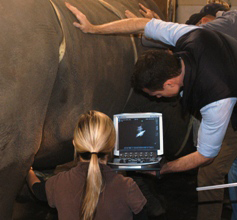November 13, 2013
Successful rhinoceros procedure by the Veterinary Health Center and Rolling Hills Zoo

James Carpenter, professor of zoological medicine, and Warren Beard, professor of equine surgery, led a team from the Veterinary Heath Center at Kansas State University to assist Rolling Hills Zoo in treating a patient of massive size on Friday, Nov. 8. A 2-ton, 34-year-old white rhinoceros named Milton was immobilized so center specialists could biopsy a mass on the animal’s abdomen.
The white rhinoceros, native to Africa, is one of five endangered species of rhinos and is actually closely related to the horse.
Upon the team’s arrival, Rolling Hills’ veterinarian Danelle Okeson administered anesthetics and, with the help of the large teams of Rolling Hills Zoo and K-State's center personnel, the rhino was stabilized in a standing position that allowed the team to perform the diagnostic procedure.
The Veterinary Heath Center team led the procedure to obtain samples of the mass, a well-vascularized external growth larger than a human hand. First, the mass was examined through an ultrasound to provide guidance through the rest of the procedure. Beard then extracted samples of the mass to be examined for abnormalities.
Within minutes of the completion of the procedure, the rhino was mobile, safely walking around his secured area.
"It was a combination of great planning and organizing by Dr. Okeson and the Rolling Hills Zoo team, terrific assistance in diagnostics by Dr. Beard and the equine team, and great collaboration by the students on the zoological medicine clinical rotation," Carpenter said. "Everything was done safely. Everything was accomplished that we had planned, and it was a great and memorable experience.”
The preliminary diagnosis is the mass is an epidermal hyperplasia similar to a callous. The samples will be submitted to the Kansas State Veterinary Diagnostic Laboratory for examination.
